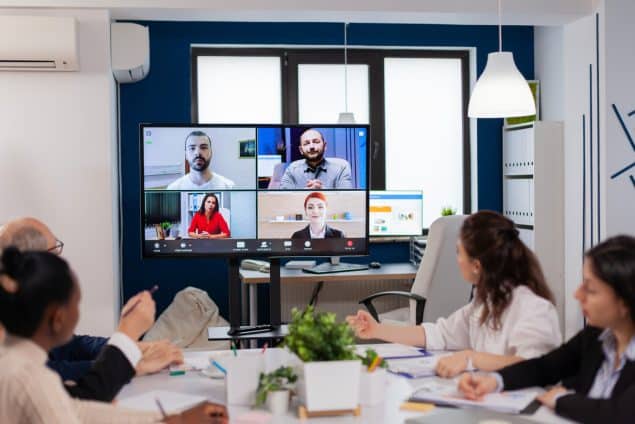Home » News Stories » How Video Conferencing Helps HR and Managers with Interviews
How Video Conferencing Helps HR and Managers with Interviews
https://www.whatjobs.com/news/news-stories/how-video-conferencing-helps-hr-and-managers-with-interviews

By Nagasunder in News Stories, posted December 3, 2021

‘Go digital, stay personal’ – This seems to be the clear motto of recruiters and hiring companies this year. More so, the digital way of interviewing and onboarding a new hire has been accelerated by the coronavirus pandemic. According to Gartner, 86% of organizations conducted virtual interviews to hire candidates in 2020 due to the COVID-19 pandemic. Live video interviewing has thus become a convenient, efficient, and affordable way to connect personally with candidates, allowing managers to create audio and video recordings of the interviews, which can help in the decision-making processes at a later stage.
With new challenges like social distancing and working from home, the hiring processes have seen a drastic change. Many corporations have even resorted to a hiring freeze. Thanks to the technological advancements, though, those who are still looking to hire have access to social media, video interviewing platforms and AI-driven recruitment tools to enhance the efficiency for both recruiters and applicants alike.
Types of Video Interviews
1. Live Video Interviews
Just imagine the usual in-person interview process but with a video screen and the comfort of your own home or office. Using a webcam, microphone, and earphones, the hiring team can connect with candidates online irrespective of their geo-location. This way of remote interviewing does not require anyone to travel to the company location and still manages to maintain a personal touch with the candidate
2. Pre-recorded Video Interviews
Pre-recorded interviews are quickly replacing telephonic screening interviews early in the selection process. Here, an online system shows questions to the candidate and they can record their best answer solo. Once complete, the system informs the hiring team to check the candidate's answers to arrive at a decision.
This is how the human resource team can benefit from using video conferencing for interviews:
1. Smooth Schedules
To schedule a face-to-face interview, the facilitator sometimes spends days and weeks finding a time slot where all stakeholders are available in the office together. A video conference interview can eliminate all scheduling issues as there is no need to be physically available at the same venue. It also reduces the cost of initial screening and collaterals required to conduct a face-to-face interview.
2. Reduction in Hiring Time and Costs
You can screen and evaluate candidates rapidly by seeing their pre-recorded interviews. Live video conferencing also allows interviewing multiple candidates together. This way, the process for hiring candidates can be done in a much shorter time. In concurrence, the cost of hiring reduces as the position closes sooner than the traditional process, which is crucial for a successful workflow.
3. Surpass Geographical Limitations
Video conferencing lets hiring managers and employers interview such candidates who are on the lookout for an opportunity to contribute remotely or are willing to relocate for a good job opportunity. Video conference interviews also overcome the challenge that comes with different time zones to a great extent, thus surpassing geographical limitations in hiring.
4. Pre-Screen Applicants
When it comes to judging a candidate’s performance based on their first impression, it takes a good amount of hiring experience and a standardized screening structure. Using video conferencing and pre-recorded interviews, you can assess applicants based on their skills, their body language, and their facial expressions. You can also screen more candidates in the same or shorter amount of time, thereby improving the chances of finding the perfect fit for the job.
5. Ensuring Positive Experience
With candidates posting their interview experiences online, it becomes important to ensure a positive interview experience. Using video conferencing for the interview process shows innovation and that your organization is at par with other technologically advanced companies. Hiring software also helps shoot automated emails to candidates for their interest and efforts, which shows that you value the candidate’s time.
6. Easy Comparison of Candidates
The drawback of the traditional hiring process lies in the inability to judge potential candidates effectively. But with video conferencing, you can go back and review the recorded interviews to compare every candidate head-to-head by assessing how they responded to a question or how they handled a given situation. This way, you can focus on the more strategically important aspects of hiring.
7. Repository of Recorded Interviews
It is nearly impossible for a hiring manager to take notes and make a fair judgment based on an hour-long face-to-face interview session with a candidate. Hence, the recording option that comes with live video interviews makes it easier to review the interview rounds as many times as needed. You can also take the opinion of other team members that were not present during the interview by showing them the recorded video.
Bottom Line:
Video conferencing is fast becoming an indispensable way to conduct interviews in the changing era of digital transformation and candidate-oriented culture. As a result, human resource leaders are increasingly deploying hiring software that makes hiring easier and faster by sourcing, engaging, and hiring the best possible talent. Hiring software increases HR’s productivity by tackling all the technicalities through automation, for example, scheduling video interviews, quickening the shortlisting process, and reviewing the candidates to make better hiring decisions.
Author Bio: Kelly Barcelos is a progressive digital marketing manager for Jobsoid – Applicant Tracking System. She is responsible for leading the content and social media teams at work. Her expertise and experience in the field of HR enable her to create value-driven content for her readers – both on Jobsoid’s blog and other guest blogs where she publishes content regularly.
Follow WhatNews on YouTube, Twitter, Linkedin, and Facebook











